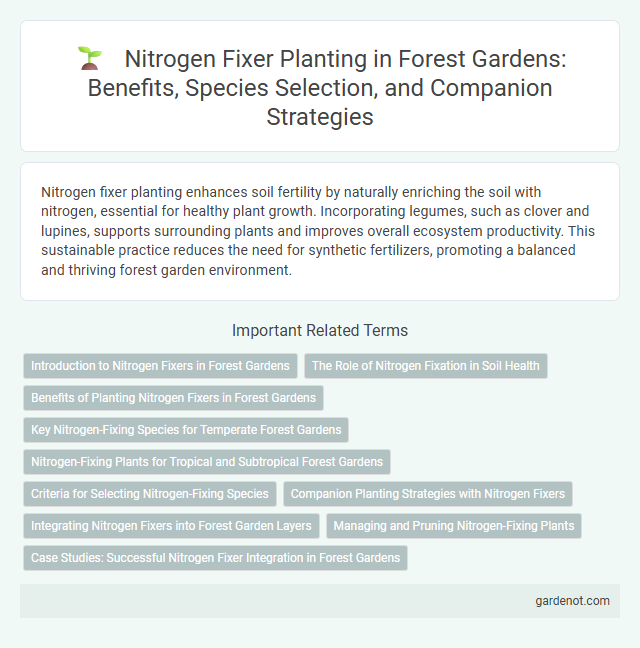Nitrogen fixer planting enhances soil fertility by naturally enriching the soil with nitrogen, essential for healthy plant growth. Incorporating legumes, such as clover and lupines, supports surrounding plants and improves overall ecosystem productivity. This sustainable practice reduces the need for synthetic fertilizers, promoting a balanced and thriving forest garden environment.
Introduction to Nitrogen Fixers in Forest Gardens
Nitrogen fixers in forest gardens are vital plants that enhance soil fertility by converting atmospheric nitrogen into a usable form through symbiotic relationships with root bacteria. Species such as alder, clover, and black locust improve nutrient cycling, promoting healthier growth among neighboring plants without synthetic fertilizers. Integrating these nitrogen-fixing plants supports sustainable agroforestry systems by increasing soil nitrogen levels and improving overall ecosystem resilience.
The Role of Nitrogen Fixation in Soil Health
Nitrogen-fixing plants, such as legumes and alder trees, play a crucial role in improving soil health by converting atmospheric nitrogen into forms usable by other plants. This natural nitrogen fixation enhances soil fertility, reduces the need for synthetic fertilizers, and supports robust plant growth in forest gardens. Integrating nitrogen-fixing species promotes a sustainable nutrient cycle, fostering biodiversity and long-term ecosystem resilience.
Benefits of Planting Nitrogen Fixers in Forest Gardens
Planting nitrogen fixers in forest gardens enriches soil fertility by converting atmospheric nitrogen into forms accessible to plants, reducing the need for synthetic fertilizers. These plants improve soil structure, enhance moisture retention, and promote microbial diversity, supporting overall ecosystem health. The presence of nitrogen fixers boosts productivity and resilience of forest gardens, fostering sustainable and balanced plant growth.
Key Nitrogen-Fixing Species for Temperate Forest Gardens
Key nitrogen-fixing species for temperate forest gardens include alder (Alnus spp.), black locust (Robinia pseudoacacia), and Siberian pea shrub (Caragana arborescens), all renowned for their symbiotic relationships with nitrogen-fixing bacteria. These species enhance soil fertility by converting atmospheric nitrogen into forms accessible to plants, supporting the growth of non-leguminous neighbors. Incorporating red clover (Trifolium pratense) and white clover (Trifolium repens) as ground cover further optimizes nitrogen fixation and improves overall ecosystem health within temperate forest gardens.
Nitrogen-Fixing Plants for Tropical and Subtropical Forest Gardens
Nitrogen-fixing plants such as Leucaena leucocephala, Gliricidia sepium, and Inga edulis play a crucial role in tropical and subtropical forest gardens by enriching soil fertility through symbiotic nitrogen fixation. These species enhance nutrient cycling and soil structure, promoting the growth of companion plants and increasing overall productivity without synthetic fertilizers. Incorporating fast-growing nitrogen fixers helps maintain sustainable ecosystems and supports diverse agroforestry systems in warm climate zones.
Criteria for Selecting Nitrogen-Fixing Species
Selecting nitrogen-fixing species for forest gardens requires focus on compatibility with local soil pH, climate conditions, and existing plant communities to ensure optimal growth and nitrogen fixation. Species such as alder (Alnus spp.), black locust (Robinia pseudoacacia), and certain Acacia varieties are favored due to their high nitrogen-fixing capacity, adaptability, and ability to improve soil fertility. Preference is also given to species with manageable growth habits and minimal invasiveness to maintain ecological balance within the forest garden system.
Companion Planting Strategies with Nitrogen Fixers
Nitrogen fixer plants such as clover, lupins, and alder play a crucial role in forest garden companion planting by enriching soil fertility through symbiotic nitrogen fixation. Integrating these species alongside fruit trees and vegetables enhances nutrient availability, reduces the need for synthetic fertilizers, and promotes healthier plant growth. Strategic placement of nitrogen fixers in guilds optimizes intercropping benefits, improves soil structure, and supports sustainable ecosystem functions.
Integrating Nitrogen Fixers into Forest Garden Layers
Integrating nitrogen-fixing plants such as clover, lupine, and alder into various forest garden layers enhances soil fertility by naturally enriching nitrogen levels. These species can be strategically placed in ground cover, shrub, and canopy layers to support nutrient cycling and promote healthy growth among companion plants. Utilizing nitrogen fixers accelerates ecosystem development and improves overall plant resilience in sustainable forest garden systems.
Managing and Pruning Nitrogen-Fixing Plants
Managing and pruning nitrogen-fixing plants such as clover, lupines, and acacias enhances their ability to enrich soil fertility by promoting healthy root nodules where nitrogen-fixing bacteria reside. Regular pruning prevents excessive shading and encourages vigorous growth, optimizing photosynthesis and nutrient cycling within the forest garden ecosystem. Proper management also maintains plant balance, supporting companion species and increasing overall biodiversity and productivity.
Case Studies: Successful Nitrogen Fixer Integration in Forest Gardens
Case studies demonstrate that integrating nitrogen-fixing plants such as black locust (Robinia pseudoacacia) and alder (Alnus spp.) into forest gardens significantly enhances soil fertility and boosts the growth of companion crops. For example, a study in temperate forest gardens found that incorporating crimson clover (Trifolium incarnatum) increased nitrogen levels by 30%, improving yield and plant health over three growing seasons. These findings highlight the critical role of strategic nitrogen fixer selection in optimizing sustainable forest garden productivity.
Nitrogen fixer planting Infographic

 gardenot.com
gardenot.com